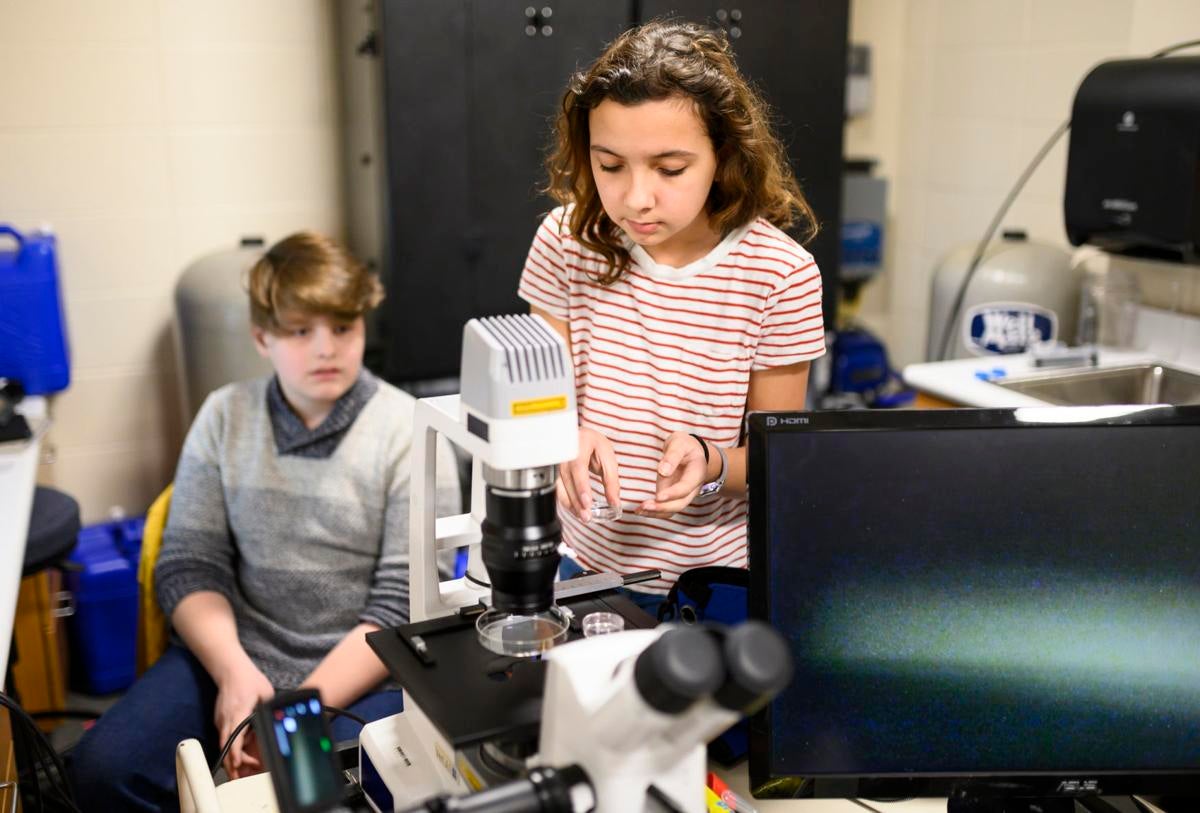News & Highlights
Topics: Clinical & Translational Research, CTSA Program, Education & Training, In the News
Lincoln Students Test Effects of Vaping on Zebrafish
Mayo Clinic InSciEd Out program teaches students in Minnesota how to test the effects of vaping on zebrafish.

Lincoln eighth-grader Sydney Schulz says she hears older students say vaping oils are harmless.
Lab research she conducted herself says otherwise.
She and her peers have been observing the effects of those oils on developing zebrafish.
On Tuesday, Julia Sanchez, another Lincoln eighth-grader, noted that in a high concentration of lavender vape oil, zebrafish had delayed development of their swim bladders. She observed three-day-old fish having trouble swimming.
“They’re trying to get upright, and they just can’t,” she said.
The students use microscopes to chart the development of the fish in various concentrations of water and vape oil. The young fish are almost transparent under light and magnified.
“You can see the blood flowing,” Schulz said.
Graham Briggs, Olmsted County director of Public Health Services, visited the school Tuesday at the invitation of school principal Jim Sonju and Chris Pierett of Mayo Clinic, coordinator of the Integrated Science Education Outreach (InSciEd Out) program that works with K-12 students. Pierett said the student-conducted research could be used to help public health officials curb vaping among teens.
Sonju said the peer-conducted research makes a compelling case against vaping.
“It’s so powerful for students to see it firsthand,” he said.
Briggs noted that vaping has nearly erased decades of decline in tobacco use among teens. He said health problems are developing faster by some vape users than is seen in traditional cigarette smokers — regardless whether there’s nicotine present in the vape products.
Corey Dornack, a Lincoln science teacher who guided some of the student research, said he heard students say they thought vaping flavor oils that don’t contain nicotine didn’t carry health risks.
“A lot of students thought those are fine,” he said.
The lab work showed otherwise.
“Right away, it made them see, ‘Wow, this might be dangerous,’ ” he said.
The first experiments the students conducted had various levels of concentrations of different vape oil in water where zebrafish eggs were hatched. Students said the higher concentration of oils was rough on the fish.
“They just died,” Schulz told Pierett and Griggs in a roundtable discussion of the tests. “It was just a mess.”
Sanchez called those early experiments “gross” and “terrifying.”
“It shows students the ‘why’ of ‘Why does this matter?’” – Chris Pierett
In the second round of tests, students observed fish developing in 10% and 1% vape oil dilutions against fish developing in water. That’s when Sanchez noted fish lying sideways and not swimming upright.
“They should be swimming by day three,” she said.
Other observations, including stunted eye growth (which hints at stunted brain development), were recorded.
Schulz watched as blood clots developed in fish exposed to a banana cream-flavored vape oil.
“I was just really surprised,” she said. “I didn’t know vape oils could do that.”
“We did witness an aneurysm in a fish,” Pierett said.
Griggs said public health efforts are aimed at prevention and not just treatment of health problems. These experiments could be helpful to demonstrate to teens the immediate health effects vaping can have.
Pierett said he hopes these experiments can be used to help educate kids caught vaping rather than resorting to punitive measures.
“Let’s toy with this,” he said. “It shows students the ‘why’ of ‘Why does this matter?’”
Originally published in Minnesota’s Post-Bulletin.

